Menu
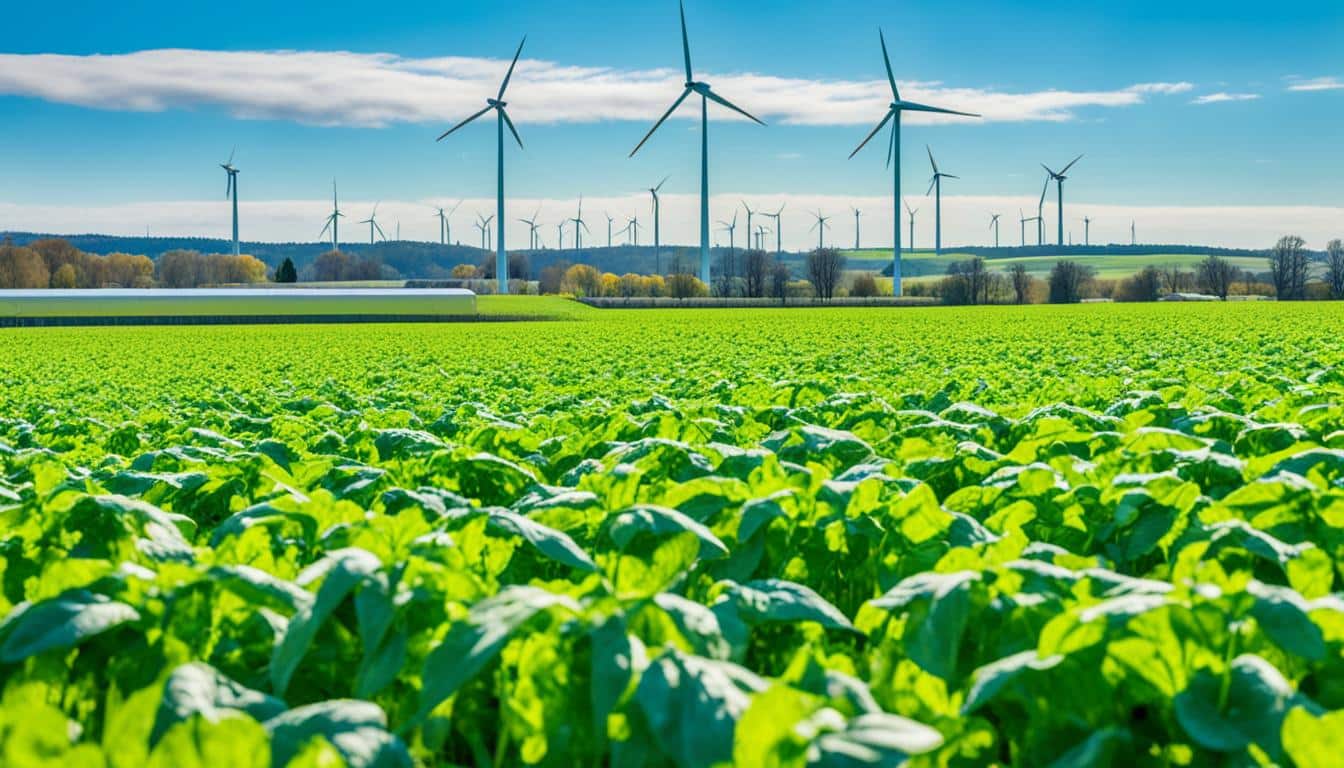
Farming is a big part of what makes our planet warm, causing about 17% of all the heat-trapping gases. This means farmers hold a key to slowing down climate change. I am a farmer who is determined to make my farm kinder to the Earth. In my work, I aim to meet a big goal: to stop adding extra heat to the Earth’s atmosphere by 2050. This target is crucial because we’ll need 56% more food by 2050. We must find ways to farm that will not harm our ability to grow food in the future.
I have embraced new ways of farming that use less energy. Companies like BASF are helping me do this, intending to shrink the amount of harm per crop by 30% within ten years. With programs such as BASF’s Global Carbon Farming, I can better watch over my land’s health. This way, I help keep our planet green while making sure the land will still feed people tomorrow. This is my way of giving back to nature and securing our food future.
Carbon-efficient farming means using methods that cut down on greenhouse gases. This helps in fighting climate change. Agriculture makes up a big part of the world’s greenhouse gas emissions, about 17%. So, it’s important to farm in ways that are good for the planet.
Cutting emissions in farming is a big job. One key issue is that benefits can be lost over time, called non-permanence. It’s crucial to show that farming projects really store extra carbon. This proves their work is making a difference.
There’s also a worry about leakage. This happens when not all the organic matter stays in the field. It’s important to prevent this. Another thing to watch for is fairness. We want to make sure that all farmers, no matter their soil quality, get a fair chance to benefit.
Measuring the carbon in soil is hard but very important. This is key for the credibility of projects that get money for trapping carbon. Sometimes, there can be arguments over which method is the best. For example, one way might reduce carbon but require more pesticides, which is not good for the environment.
Looking at Heinrich Esser’s farm, it’s clear how much better farming can be for the planet. His farm emits half as much in making wheat compared to most farms in Germany. The Climate Partner Agriculture project is proof that cutting emissions in farming works.
| Farm | CO2e per Metric Ton of Wheat |
|---|---|
| Heinrich Esser’s Farm | 150 kg CO2e |
| Average German Farm | 300 kg CO2e |
In an experiment at Heinrich Esser’s farm, they saw good results. Their wheat plot produced nearly 3% more and used much less CO2 than normal. The project aims to last ten years, looking at the whole process of growing and storing wheat.
The xarvio FIELD MANAGER tool is a technology that helps cut down CO2 in farming. It uses data to recommend how to manage crops better. These recommendations mean less CO2 and more income for farmers, promoting smart farming.
Agriculture is a key player in global greenhouse gas emissions, contributing 31% of the total. Livestock, dairy, and forestry activities play a big part. They release methane during digestion and from decomposing manure.
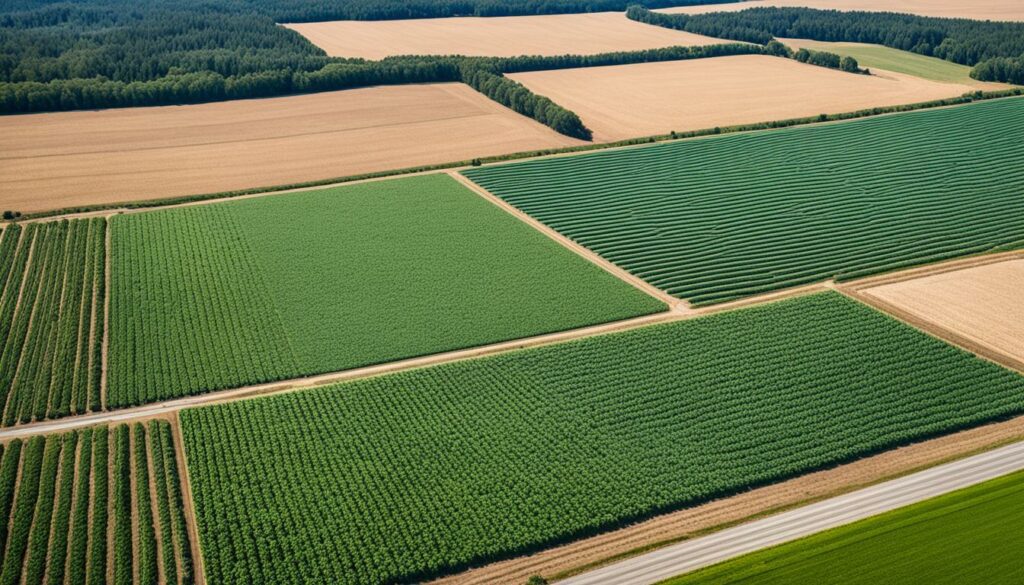
Globally, agriculture’s effect on emissions is significant. In 2007, the U.S. agricultural sector alone emitted millions of metric tons of carbon dioxide equivalents. Practices like conservation tillage can boost carbon sequestration by keeping crop residues on fields. They help store organic matter in the soil. Moving towards sustainable farming and renewable energy is critical in reducing these emissions worldwide.
Livestock methane emissions can be cut by changing the animals’ diets and by installing digesters to capture the gas. Using different methods in crop farming can also lower emissions from nitrogen fertilizers and manure. This leads to a low-carbon agriculture.
Locally, agriculture’s emissions directly impact the area’s environment. This highlights the need for more carbon-efficient farming methods. For example, using less fuel and improving efficiency reduces fossil fuel-based emissions. Techniques like no-till farming can further decrease emissions. Federal initiatives that allow agricultural activities as emissions offset could boost these efforts.
Climate-friendly policies might also need direct payments. These can encourage farmers to adopt more sustainable practices. Offering incentives, similar to those in the Conservation Reserve Program, supports these efforts. Policies promoting renewable energy, such as the Renewable Fuel Standard, are also key. They encourage farmers’ involvement in renewable production and sustainable farming techniques.
Moving to sustainable soil management was a big step for me. I used to follow traditional farming methods. But I chose to switch to eco-friendlier ways. This change needed me to rethink everything I knew.
Seeing how much hurt traditional farming caused our planet scared me at first. Farming is vital for many jobs, but it harms the environment. It makes over 10% of the greenhouse gases.
However, the world needed to change. New, green farming could create more jobs and help our planet. This pushed me towards a sustainable path.
Transitioning to eco-friendly farming wasn’t easy. I started with the soil. I used cover crops to protect against erosion and boost health. I also used nitrogen carefully, avoiding harm to the environment.
Studying data on carbon loss opened my eyes. It showed despite efforts, soils were still losing carbon. So, I focused on better methods. I worked to managemanure better and improve peatlands. These actions made soil better at holding water. They also cut the need for chemical fertilisers, helping with pollution.
This journey into sustainable agriculture is an ongoing one for me. It’s about always trying ways to be kinder to the earth. And as I do this, I’m seeing good changes. This just proves how important sustainable farming is for our future.
Crop rotations have become a key part of my farming methods. They have greatly improved how I manage soil. This approach lets me deal with many soil problems. It makes my farm more able to bounce back from issues and be more productive.
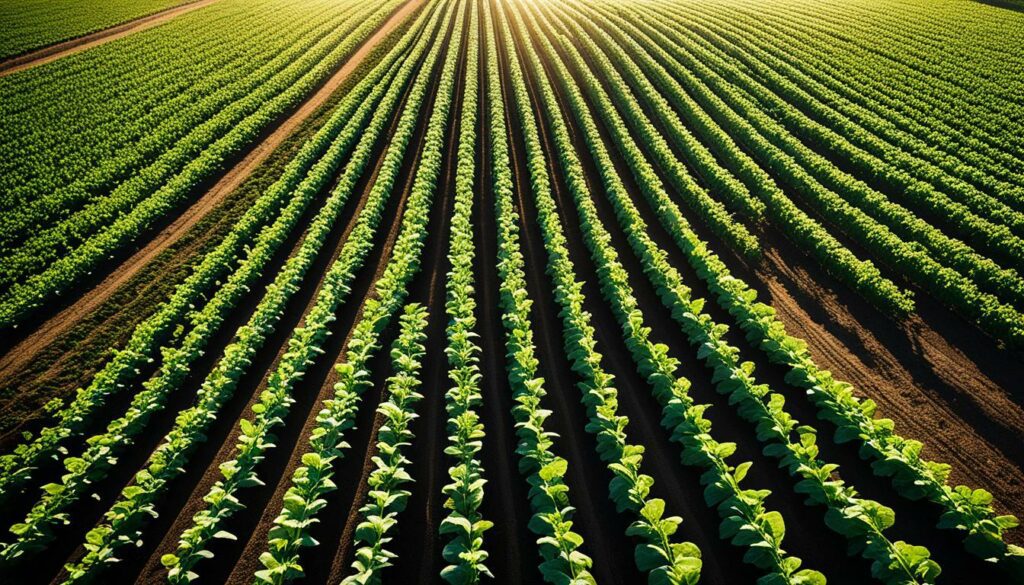
Using different crops like arable, legumes, and cover crops is crucial. It helps to stop pests and diseases. It also boosts soil health through varied root systems. For example, legumes can take nitrogen from the air, cutting the need for artificial fertilizers.
Raising livestock can also help. It adds organic matter to the soil with their manure. This improves soil structure and can bring in more money.
Approximately 78% of the air is nitrogen, showcasing the potential of leguminous plants to fix nitrogen and reduce the need for artificial fertilizers.
Ploughing less often, like once every three years, greatly improves soil. This method is called conservation ploughing. It helps the soil keep its shape and bounce back better.
Putting cover crops between regular crops, like in winter and spring, also does wonders. They keep the soil together and use leftover nutrients. This makes plant food go further.
Keeping an eye on how many earthworms you have can tell you a lot about your soil. Their presence shows that the soil is alive and healthy.
| Practice | Benefit |
|---|---|
| Diversified Rotations | Increase yield by up to 38% |
| Legume Inclusion | Increase soil organic carbon stocks by 8% |
| Conservation Ploughing | Improve soil structure and resilience |
Choosing the right cover crops, with mixes of at least three types, is key. By focusing on crop variety, I’ve improved my soil’s health a lot. It’s made my farming more sustainable for the future.
The 4R Nutrient Stewardship approach is key to sustainable farming. It focuses on the Right Time, Right Rate, Right Source, and Right Place for fertiliser use. Following these steps, I boost crop growth while lowering harm to the environment.
Applying nutrients at the best time helps prevent losses. Matching nitrogen with plants’ needs boosts nutrient intake and cuts harm to the environment. This method is a vital part of being eco-friendly.
Choosing the proper fertiliser amount improves nutrient use and output. By measuring and applying just enough, you lower the chance of overuse and run-off. Using records and monitors helps set goals for long-term success.
Picking the right fertiliser is critical for good plant nutrition. It stops too many nutrients from moving to groundwater. Choosing correctly is essential in sustainable farming.
Putting nutrients in the best spot cuts environmental risks and helps crops grow well. Techniques like banding fertilisers near roots reduce pollution risk. Good placement is crucial for eco-friendly farming.
| 4R Principle | Benefit |
|---|---|
| Right Time | Maximises nutrient uptake and minimises volatility |
| Right Rate | Prevents over-application and runoff |
| Right Source | Balances plant nutrition effectively |
| Right Place | Reduces environmental pollution risk |
Adopting the 4Rs with advice from crop experts leads to better use of fertilisers. This promotes a strong farming system that cares for the environment.
Leaving land unplanted causes big environmental issues. Greenhouse gas emissions are high, with 31% from farming. We need to move to farming with fewer emissions for the earth. This means using the land wisely to keep it productive and green.
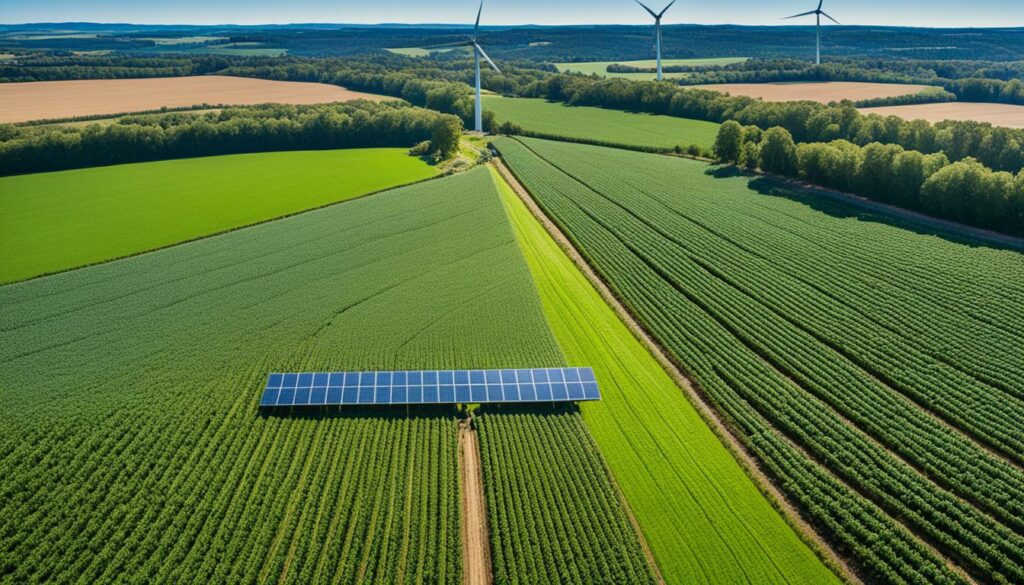
Bare fallow harms the earth in many ways. It makes soil erosion worse and lowers its quality. This increases the carbon in the atmosphere. To stop this, we must care for the soil well to cut greenhouse gases.
There are better ways than leaving land bare. Planting cover crops is one good option. They protect the soil, keeping it healthy. Cover crops make the soil structure better and hold water well.
Smart technology, like using data to choose the best crops, helps a lot. It lets us use nutrients better and use less chemicals. Companies, including ICL, offer products that make farming greener.
By saying no to bare fallow and choosing smart options, we help the planet. These changes are good for nature and make farming better in the long run.
Minimising tillage is key in climate-smart agriculture. It’s vital for a big cut in the field’s carbon footprint. This technique keeps the soil healthy. It does so by not disturbing it much, using less fossil fuel. It locks more carbon in the soil and adds to its richness.
In organic farms that use less tillage, soil carbon grows by 1.7% to 3.6% more than others. This is a big deal for growing crops well, especially now with our changing climate.
Using less tillage helps farmers save a lot of money on fuel. They don’t need to move their tractors around so much. This cut also means there’s less carbon put into the air. Plus, no-till farming means less work, making it a smarter choice than the old ways.
“Greenhouse gas emissions from agriculture saw a 6% increase between 1990 and 2020, highlighting the need for sustainable changes in farming practices.”—Agritech Tomorrow
No-till farming really stands out in keeping a lot of carbon in the soil. As Agritech Tomorrow points out, using pivot irrigation with no-till lets farmers avoid soil damage. This keeps the farm productive, even on bumpy ground.
Using the old tillage methods harms the soil and the air. It also makes farms less productive. But, using less tillage boosts soil health. This makes farms better able to hold water, which helps plants grow.
| Aspect | Conventional Farming | No-Till Farming |
|---|---|---|
| Soil Organic Carbon Growth | Low | 1.7% – 3.6% Higher |
| Fuel Costs | High | Significantly Reduced |
| Labour Requirements | High | Low |
| Soil Disturbance | High | Minimal |
| Greenhouse Gas Emissions | Increased | Decreased |
Changing to less tillage takes time. But sticking with it brings huge benefits. It’s a central part of making farming both eco-friendly and profitable.
Staying on top of soil health is key for farming that lasts and good crops. By carefully sampling soil, we learn about its nutrients, organic matter, and more. This knowledge helps us look after the soil in a way that keeps making good food without harming the earth.
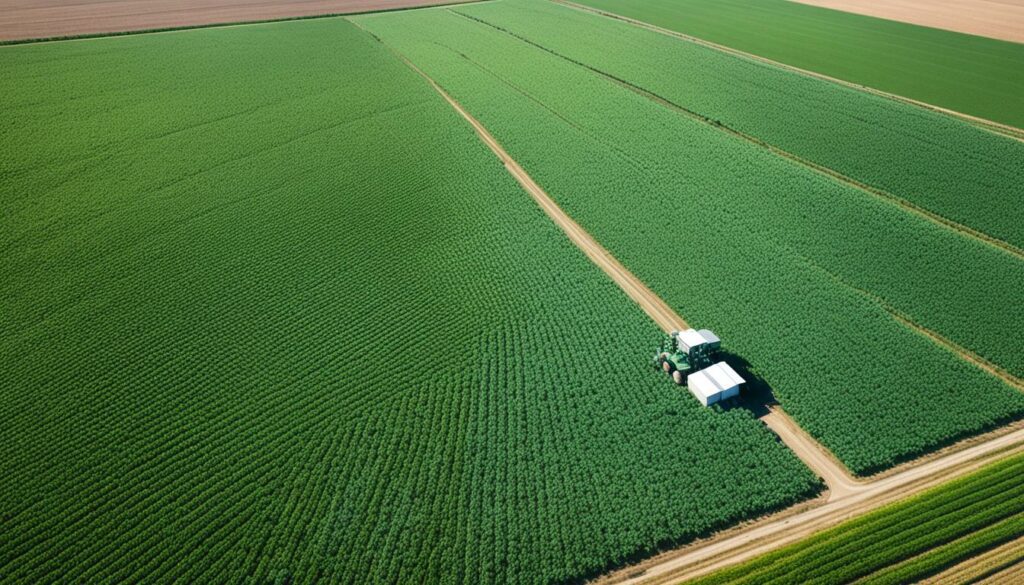
Agricultural soil health is crucial for growing crops well and protecting the environment. In the UK, there’s a big difference in the level of organic matter in the soil, from 1% to 7%. This organic matter largely comes from carbon, making up 58% of it. Good soil management keeps our soil rich and able to grow food for a long time, which is essential for farming that doesn’t wear out the land.
To get the right soil info, it’s key to choose typical spots and sample the same way every year. It’s best to take at least 20 small samples from one area. Most of the carbon is in the top 10cm of soil. But it helps to take samples deeper to understand the soil’s overall wellness.
| Soil Property | Range | Impact |
|---|---|---|
| Soil Organic Matter | 1% – 7% | Influences soil fertility and structure |
| Soil Bulk Density | 0.8g/cm3 – 1.8g/cm3 | High density (>1.6g/cm3) affects root growth |
| pH | 5.5 – 8.5 | Affects nutrient availability |
Tracking soil health through smart sampling and analysis helps us make good choices. These choices promote a way of farming that’s both productive and gentle on the planet. By doing this, we can better the health of our crops while protecting our environment, leading to a future of sustainable farming.
Cover crops are key to sustainable farming. They bring many benefits for the environment and help farms be eco-friendly. In 2017, farmers planted cover crops on 15.4 million acres. This was half as much more than five years ago.
Cover crops are crucial for the health of the soil. They boost organic matter, which is good for soil nutrients and keeping it fertile. Between 2012 and 2017, more farms started using cover crops, up by 15.2%.
Legumes, a type of cover crop, can fix nitrogen in the soil. They add between 50 to 150 pounds of nitrogen per acre. This is a big help for soil health.
Cover crops are also great at stopping soil erosion. Heavy rain in the Northeast US has made this more important. Cover crops act as a shield, stopping the soil washing away and keeping nutrients in. They help in organic farming by managing weeds, adding nitrogen, and improving soil health.
They also help keep soil moist, provide homes for helpful insects, and cut a farm’s carbon footprint. This all shows why eco-friendly and sustainable farming is so important. It helps farms last longer and take care of our planet better.
| Benefit | Impact | Statistics |
|---|---|---|
| Increased Crop Yield | Improved yield in corn and soybeans after consistent cover crop use | 3% corn, 4.9% soybeans after five years |
| Soil Erosion Control | Reduces nutrient runoff and protects against heavy rains | Significant reduction in soil erosion observed |
| Improved Soil Fertility | Enhances nutrient cycling and organic matter | More than doubled acreage in certain states from 2012 to 2017 |
Good manure management helps soil and prevents too many greenhouse gases. Following smart farming methods makes the land healthier and more productive. Here are some ways to do that.
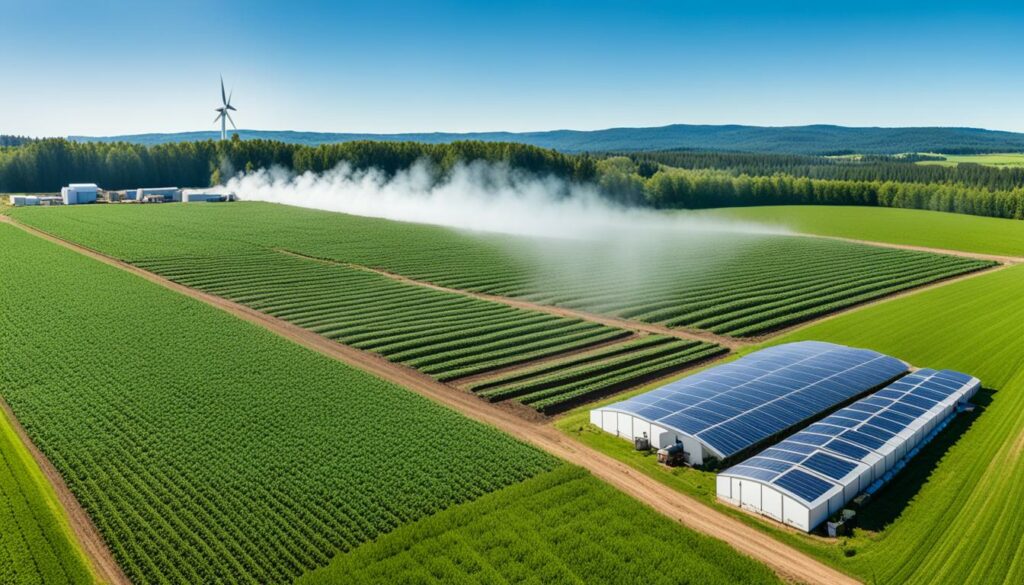
Using the 4Rs for manure (Right Source, Right Rate, Right Time, and Right Place) is key. It means we use nutrients well, lessening harm to the environment. Using manure at the perfect time and amount keeps nutrients in the soil where they help and don’t harm.
Being precise with when and how much manure we use keeps nutrients balanced and lowers gases. Globally, manure is part of about 10% of all livestock greenhouse gas emissions. Of this, 5% is nitrous oxide (N2O) and 4% is methane (CH4).
Here are some ways to improve:
| Method | GHG Reduction | Additional Benefits |
|---|---|---|
| Daily Spread | Reduces Methane | Less Emission Consumption |
| Composting | Decreases Methane by 20-40% | Enhanced Soil Quality |
| Anaerobic Digestion | Significant Methane Reduction | Renewable Energy Production |
| Flexibiogas Systems | Lower Carbon Footprint | Suitability for Smallholders |
Using these methods fits with being kind to the planet and also makes soil and farming better. By using these ideas, we can make agriculture both sustainable and successful. This way, we get the most out of manure while keeping the Earth greener.
Using renewable energy and efficient equipment is key to sustainable farming. It helps lower the carbon footprint of farming practices. It also saves a lot of money for farmers.
Solar and wind power cut down the carbon footprint. Solar is easy to get and cuts down electricity bills. Places with lots of wind are perfect for wind turbines. Using these clean energies means less greenhouse gas.
Going green also means saving money. The REAP program can pay for half of the costs. Together with a tax credit, it’s possible to pay much less for solar. State rebates also help to make things more affordable.
Biofuels like biodiesel lessen the need for fossil fuels. It’s part of the move to eco-friendly farming. There are also grants that help reduce the cost of upgrades.
Another good help is a mix of grants and loans. It can cover up to 75% of renewable energy costs. With an 80% loan guarantee, these investments pay off. It’s good for both the environment and the pocket.
| Program | Support Offered |
|---|---|
| Rural Energy for America Program (REAP) | Up to 75% project funding through combined grants and loans |
| Investment Tax Credit (ITC) | Reduces federal tax liability by up to 30% for solar systems |
| Agriculture Energy Efficiency Rebate | Rebates for energy-efficient projects |
| Small Business Advantage Grant (SBAG) | Partial reimbursement for energy efficiency improvements |
Adequate fertiliser use is key to better crop yields and quality. It helps in managing soil sustainably. Thanks to new tech, fertilisers can be applied more accurately. This cuts down on waste and is better for the environment.
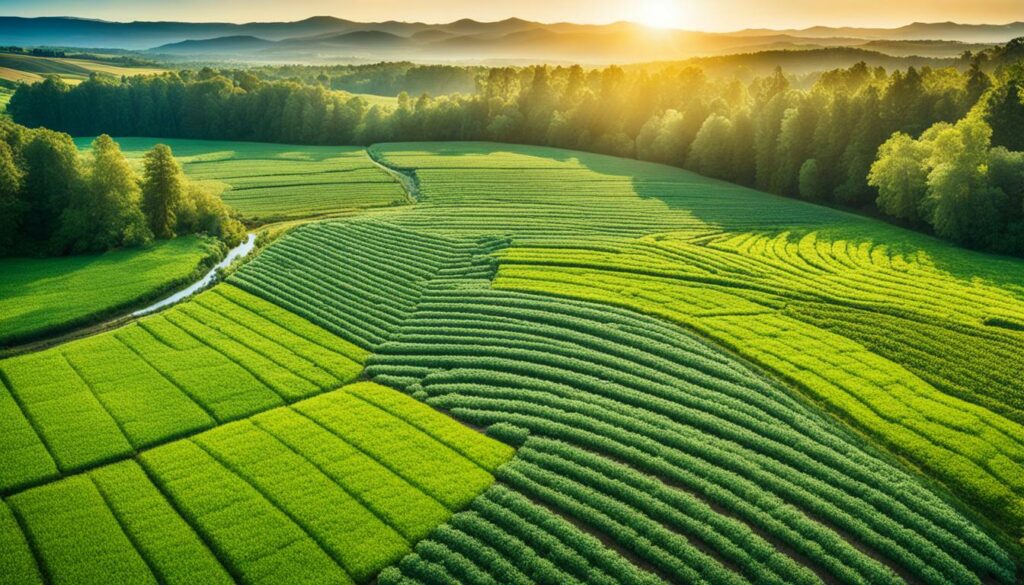
The agri-food sector makes up 31% of human-made greenhouse gases. As food demand rises, we need fertilisers for healthy soil. They prevent soil from losing important nutrients. So, the land stays productive for many generations.
Companies like ICL are making fertilisers that work better. They aim to use nutrients, like phosphorus and nitrogen, more efficiently. This is not just about increasing crops. It’s also about reducing the harm farming does to the planet. Almost all the nitrous oxide in the world comes from farms. Better fertiliser use is a must to stop this.
A recent study brings light to nitrogen use. It shows that too much nitrogen gets wasted in some areas. When not managed properly, up to 85% of it can be lost. But, using nitrogen better doesn’t just save it. It means more profits for farmers. By using new soil tests, we can predict nitrogen needs better. This leads to better soil care and happier farms.
Here is how nitrogen use looks in different areas:
| Region | Nitrogen Recovery Rate at Harvest |
|---|---|
| Average Global | 71% |
| High Rainfall Zones | 85% loss with excessive fertiliser |
| Efficient Management Areas | 40% – 60% loss reduction |
Working together is crucial to reduce agriculture’s carbon footprint. By using new fertilisers wisely, we help the environment. We can lower greenhouse gases. This makes the land better for growing food, for now and the future.
Embracing AgTech solutions has changed the game for modern farming. It lets me make smart moves based on data. These systems use a lot of farming data to boost how much we produce and cut down on waste. They match what the FAO says about farming better.
Precision agriculture is really important in data-driven farming. It lets us use our resources right where they’re needed. This wastes less and helps us grow more. Younger farmers especially like using digital tools. These tools help them make better choices quickly with up-to-date data and automatic fixes.
Integrating a data-driven system makes farming more efficient. It smooths out our tasks and uses water and fertilisers smarter. This cuts down on what we use from outside and makes better use of what’s already there. It’s good for the earth and helps keep plants and animals in a better place.
So, AgTech tackles big problems like helping the environment, society, and the economy. It does this by making farming smarter and more efficient. This way, we meet the challenges of today in the best way.
In the past few years, the farming industry has made big strides in cutting down on its carbon output. New methods and technologies are playing a key role. They are not just reducing harm to the environment. They are also making farming more sustainable and productive.
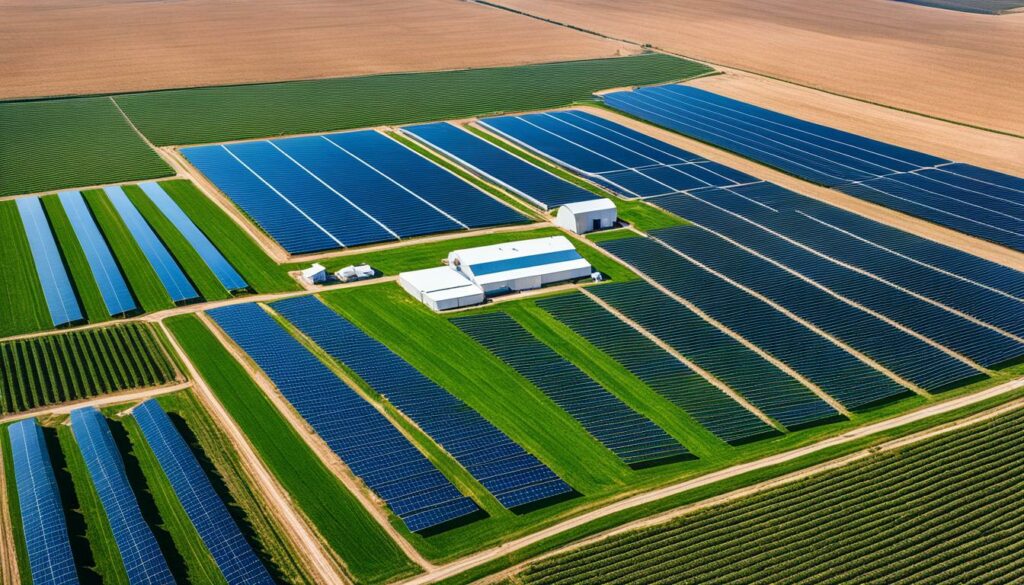
Advanced fertilisers and biostimulants are at the forefront of this change. They help plants use nutrients better, reducing the need for old, harmful methods. By doing this, they make the soil healthier. This means plants grow stronger and produce more food or crops.
Take Brazil as an example. They’ve put in place a plan that could cut down 1 billion tons of CO2. This plan covers an area as big as 72.6 million hectares.
AgTech solutions are changing how we see farming today. They bring together technology and agriculture. With tools like drones and smart sensors, farmers can be more exact. This not only saves time and money, it also helps the environment a lot.
Events like the Low Carbon Agriculture Show in Warwickshire show that many people are interested. They want to find new ways to farm that are good for the planet.
Using these AgTech solutions and the latest in fertilisers and biostimulants is vital. It guides agriculture towards a sustainable future. We can grow food and other crops in ways that don’t harm the earth.
We must deal with the impact farming has on our planet. This is vital to stop the climate from getting warmer. It’s also key for there to be enough food for everyone as our world’s population grows.
In 2007, America’s farms were putting out a lot of CO2. This amount showed that we must make farming more earth-friendly. We can do this by changing how we plant crops and look after the land. It’s about using less chemicals, managing nutrients carefully, and turning to clean energy options.
There are smart ways to farm that don’t harm the planet as much. For instance, using less fertiliser on our crops and better ways to take care of animals. These changes can cut down on harmful gases. They can also make farms more money.
Making these changes might seem tough, but help is available. For example, there are special programmes and trading rules that reward farms for being green. Moving towards these goals is good for nature and makes solid economic sense.
By working together, farmers and experts can find ways to farm that are kinder to the earth. They can also still make a living. Joining programmes that encourage greener actions, we pave the way for sustainable farming. This not only helps our planet but also ensures a bright future for those who come after us.
Carbon-efficient farming cuts down on harmful gases. It aims to make farming activities less polluting. This helps fight climate change and keeps our planet healthy.
Sustainable farming is all about healthy, profitable, and fair practices. It uses methods like changing crops, watching nutrients, and not tilling as much. Unlike the tradition, it avoids lots of chemicals and growing just one crop.
Agriculture creates about 31% of the world’s greenhouse gases. Different foods and farming ways add up to this big number. To lessen the harm, we must farm in ways that care for the earth.
Changing the crops helps the soil in many ways. It makes the land rich with different plants and good microbes. This reduces sickness in the crops and makes the soil better at feeding them.
The 4Rs say we should give plants food just right. It means the right amount, at the right time, from the right place. Doing this well helps crops grow better and stops waste.
Leaving fields bare is bad because it harms the soil and wastes what it can do. Using cover crops is a better choice. They help the earth stay rich and stop it blowing away.
Less tilling means we use less fuel and the soil stays strong. The earth then holds onto more carbon, which is good for cutting how much we harm the climate.
Testing the soil lets us know what it needs. This helps farmers do what’s best for their soil and the plants that grow in it. It’s a smart way to take care of the land.
Cover crops add good things to the soil. They stop it getting washed away, help with plant food, and keep the soil’s power to grow plants. They are important for keeping farming green.
Handling manure well means using the 4Rs carefully. This keeps the nutrients in the ground, where they help plants and don’t pollute. Good practice makes the land more productive and less damaging.
Green energy and smart machines cut down on pollution from farms. They are good for the planet and can save money too. It’s a win-win for the earth and farmers.
The right amount of fertiliser makes plants grow strong and keeps the soil healthy. New kinds of fertilisers are very exact, so there’s less waste and harm. It’s a step towards farming that lasts.
This system uses tech to make farming smarter. It puts just enough of what plants need, where it’s needed. Doing this saves resources and makes the land more fruitful, without waste.
New ideas in fertilisers and AgTech make farms cleaner and more efficient. They help plants grow better and bounce back from hard times. These green practices are key to future farming, helping the planet breathe easier.